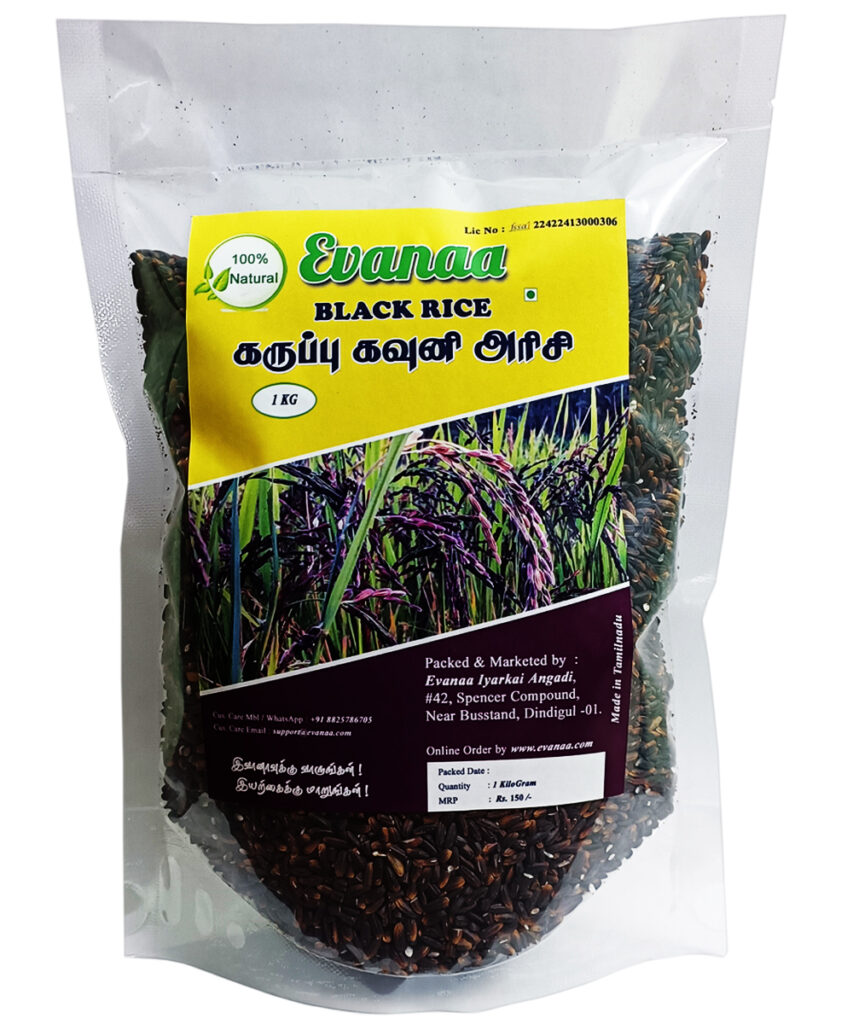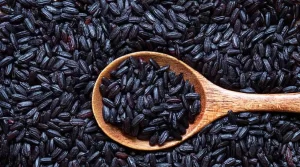
Why Choose Black Rice?
Black rice, also known as purple rice or forbidden rice
Black rice has a deep black color and usually turns deep purple when cooked. Its dark purple color is primarily due to its anthocyanin content, which is higher by weight than that of other colored grains.
Several nutrients with one source
Black rice is a good source of several nutrients, particularly protein, fiber, and iron.
USDA Nutrition Value per 100g
| Name | Amount | Unit |
| Energy | 356 | kcal |
| Protein | 8.89 | g |
| Total lipid (fat) | 3.33 | g |
| Carbohydrate, by difference | 75.56 | g |
| Fiber, total dietary | 2.2 | g |
| Sugars, total including NLEA | 0 | g |
| Calcium, Ca | 0 | mg |
| Iron, Fe | 2.4 | mg |
| Sodium, Na | 0 | mg |
| Vitamin C, total ascorbic acid | 0 | mg |
| Vitamin A, IU | 0 | IU |
| Fatty acids, total saturated | 0 | g |
| Fatty acids, total trans | 0 | g |
| Cholesterol | 0 | mg |
Antioxidants Level
black rice is especially high in several antioxidants
Antioxidants are compounds that protect your cells against oxidative stress caused by molecules known as free radicals
They’re important, as oxidative stress has been associated with an increased risk of several chronic conditions, including heart disease, Alzheimer’s, and certain forms of cancer.
black rice contains over 23 types of antioxidants and has the highest antioxidant activity of all rice varieties.
Include Anthocyanin compound
Anthocyanins have strong anti-inflammatory, antioxidant, and anticancer effects
Anthocyanin is a pigment that’s responsible for the black-purple color of forbidden rice. It’s also been found to have potent anti-inflammatory, antioxidant, and anticancer effects.
Heart Health
Studies suggest that eating black rice regularly may help lower bad cholesterol levels and promote good cholesterol
Anticancer properties in black rice
Anthocyanins from black rice may also have potent anticancer properties.
A review of population based studies found that higher intake of anthocyanin-rich foods was associated with a lower risk of colorectal cancer
Furthermore, a test-tube study found that anthocyanins from black rice reduced the number of human breast cancer cells, as well as slowed their growth and ability to spread
While promising, more research in humans is needed to fully understand the ability of the anthocyanins in black rice to reduce the risk and spread of certain types of cancer.
Eye Health
black rice contains high amounts of lutein and zeaxanthin — two types of carotenoids that are associated with eye health
Black rice contains the antioxidants lutein and zeaxanthin, both of which have been shown to protect your retina from potentially damaging free radicals. While anthocyanins may also protect eye health, research in humans is currently lacking.
Defaultly Gluten-free
black rice is a nutritious, naturally gluten-free option that can be enjoyed by those on a gluten-free diet.
Help to weight loss
Black rice is a good source of protein and fiber, both of which can help promote weight loss by reducing appetite and increasing feelings of fullness
Special Benefits
sugar levels. Animal studies suggest that eating black rice and other anthocyanin-containing foods may help reduce blood sugar levels in those with type 2 diabetes. Human studies are needed to confirm these effects
non-alcoholic fatty liver disease (NAFLD). A study in mice found that adding black rice to a high fat diet significantly reduced fat accumulation in the liver
While not as common as other types of rice, black rice is the highest in antioxidant activity and contains more protein than brown rice.
As such, eating it may offer several health benefits, including boosting eye and heart health, protecting against certain forms of cancer, and aiding weight loss.
Black rice is more than just a nutritious grain. When cooked, its deep purple color can turn even the most basic meal into a visually stunning dish.











